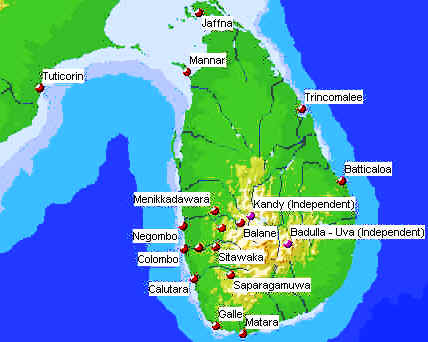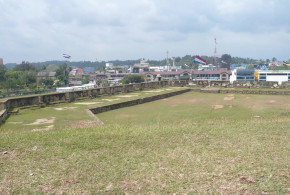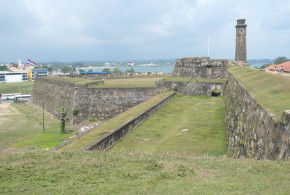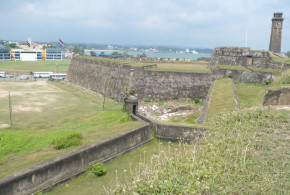Written by Marco Ramerini. English text revision by Dietrich Köster.
COLOMBO: The city of Colombo, the main city of today’s Sri Lanka, was founded by the Portuguese. The first Portuguese attempt to settle in Colombo was done in 1518, when the Viceroy Lopo Soares de Albergaria landed in Colombo with a large fleet. Here the Portuguese soldiers began to build a small fort named Nossa Senhora das Virtudes or Santa Barbara. This first fort was triangular in shape surmounted by a central tower. It was short-lived, because the Singhalese soon besieged the fort and around 1524 the Portuguese were forced to dismantle it.
The second attempt was made in November 1554. Duarte de Eça with 500 soldiers built a new fortress in Colombo. Thus November 1554 can be fixed as the date of birth for the city of Colombo. In July 1565 the Portuguese decided to transfer the Court and the capital of the Kingdom of Kotte to Colombo; thus Kotte was abandoned.
“Columbo, from being a small stockade of wood, grew to be a gallant city, fortified with a dozen bastions; it is true these were six-sided according to the ancient fashion and of small size, but they were conveniently situated.” “Its artillery consisted of two hundred and thirty-seven pieces of three kinds, from ten up to thirty-eight pounds, all mounted.”
The town “is situated on a bay capable of holding a large number of small ships, but exposed on the northern side; and its line of circumvallation stretched over one thousand and three hundred paces.” “On the Punta do Recife, which is to the south, there was a large breastwork named Santa Cruz, provided with the heaviest kind of artillery; this commanded and defended the whole of the harbour.
From here the open city extended to the south through what was known as the Galvoca, which on account of the ridge of rocks required no ramparts; at the end of this and right on the sea was a bastion. The ditch commenced at its foot and ran on with a new rampart and another bastion called Mapane, where a gate with a drawbridge existed, the two continuing side by side till they reached the lake, being finished off by the bastion of São Gregório. From the sea up to this point was the best fortification, which the city had, and it was in no way inferior to that of the lake itself, which encircled it for a distance of four hundred paces and was more than two leagues in circumference and abounded with crocodiles. One hundred paces beyond this bastion was another alongside a large house and a powder factory.”
“From here there started a brook, which crossed the middle of the city and was provided with two bridges. A low wall ran down side by side with the lake till it reached the bastion of St. Hierónimo, where the lake ended. In the middle of this stretch rose the bastion of Madre de Deus; further on was the Porta da Rainha, and close to it the bastion of St. Sebastião, from the foot of which started a moat. which was continued past the base of the bastion of St. Estevão and finished at the gate and bastion of São João with another drawbridge. This was the most northerly point of the city, and from here a strong stockade of pointed beams ran along the shore as far as the sea. At this point the bay opened and there was a handsome breastwork in front of the college of the Society; beyond lay the bastion of the Customs-House and the rampart ran till it finished with the breastwork of Santa Cruz.”
“There were in the city nine hundred families of noble settlers and more than one thousand five hundred men of various handicrafts and tradesmen, all within the walls; two parishes, the Mother Parish and that of São Lourenço; five convents of the religious orders, those of São Francisco, São Domingos, São Agostinho, that of the Capuchins, and the College of the Fathers of the Society (Jesuits), who held classes in Latin and Morality; the Santa Casa da Misericórdia, and a Royal Hospital, with seven parishes outside the walls.”
GALLE: “The fortress of Galle was built on a point of land with the sea on two sides; on the north was a steep line of rocks, and there it had no other defence. On the south side was the bay, protected by a palisade of pointed beams; while a line of ramparts with its moat and three bastions cut across the land side from sea to sea, with a gate and drawbridge in the middle; the position was well protected with this fortification.” Galle, during Portuguese time “was merely a fortress” and not a city as Colombo, inside the fortress lived two hundred and sixty two families of Portuguese and six hundred men of various handicrafts, the Captain of the garrison, the Adjutant and a parish priest. Just as Colombo Galle had also a Santa Casa da Misericórdia, a Hospital, a Customs-House and a convent, that of São Francisco.
CALITURE: “Caliture, was a very small fortress built on a hill at the mouth of a river of the same name.” “It had two small bastions with four iron cannons, a garrison of one infantry company, a chaplain and a magazine of stores and ammunition”
NEGOMBO: “Negumbo, had a Captain with some invalid soldiers; was a square enclosure of stone and mortar with two redoubts, both were small and plain, with five iron cannons, a chaplain, and a magazine of stores and ammunition.”
MALWANE: “Malvana, stood on the bank of the river about three leagues from Columbo, and was also small with a square redoubt, not protected on the flank” Malvana, had its Captain, a chaplain, and a garrison of soldiers; there were also a church, and a magazine of stores and ammunition.
BATTICALOA: “Batecalou, was built on a point of land and protected a bay capable of receiving vessels with high sides. It was a square structure with four bastions of ancient design armed with a dozen iron cannons, and its garrison consisted of a Captain and fifty soldiers with twenty settlers, a constable, a chaplain, a church and a magazine of stores and ammunition”
TRINCOMALEE: “Trequimalee, was a triangular fortress with three bastions carrying ten iron cannons, built on a hill at a point of land adjoining the sea, close to the Baia dos Arcos. A Captain was in charge of it with fifty soldiers, and there were also a constable, sixteen settlers, a chaplain, a church and a magazine of stores and ammunition”
JAFFNAPATAM: “Jafanapatao, a quadrangular fortress, had fout bastions and four half-moons or cobelos in the middle of the line of ramparts, all of which were built of pumice stone” (maybe coral stone). “In Jafanapatao, resided the Governor, the town was on one side outside the walls of the fort and there lived “three hundred Portuguese families and seven hundred handicraftsmen, with the Convents of São Francisco and São Domingos, the College of the Society, the Igreja Matriz, the Santa Casa da Misericórdia and the Hospital. Two leagues away, at the mouth of the channel, was a fort with good artillery and garrisoned by a company of infantry. The full number of men for the defence of Jafanapatao was two hundred Portuguese forming six companies, with some native Lascarins”.
MANNAR: The fort of Manar was built on the island of the same name and the territory pertinent to Manar comprised also the lands of Mantota on the main island. “It was a very small fortress, four sided, with two small redoubts on the two opposite angles, overlooking the strait. It had no infantry garrison, but stretched alongside of it was a settlement of one hundred and fifty families of Portuguese and two hundred of handicraftsmen; a Captain also resided here”
MENIKKADAVARA: (Dissava of Four Korales) Menikkadavara, was situated in the Four Corals and was the main camp base for defending the Seven Corals and for opposing the Kandian Kingdom, the walls of the camp were made of earth. “Manicavare, was further the residence of the Dissava”….”who always had at his disposal during peace time three or four thousand Lascarins with their officers, whose number could be greatly increased in the event of war”. The Portuguese forces stayed in Menikkadavara. They “consisted of twelve companies of three hundred and fifty Portuguese soldados under the command of the Captain-Major of the field, and there were also a Sergeant-Major, two Adjutants, a Captain of Munitions and a Franciscan monk as chaplain”
SABARAGAMUWA: (Dissava of Sabaragamuwa) “In Sofregao was another camp controlling all the territory as far as the frontiers of Uva; this consisted of four companies of one hundred and fifty Portuguese infantrymen under the command of the Dissava of the district, with an Adjutant, a Franciscan monk as chaplain, and four or five thousand well-equipped Lascarins”. The walls of this camp were also made of earth.
MATARA: (Dissava of Matara) The Dissava of Mature district resided at Mature, “with one company of infantry, a Franciscan monk as chaplain, and three or four thousand Lascarins”….”His jurisdiction extended as far as the frontiers of Uva and Batecalu and along the sea-shore up to Columbo”
SEVEN CORALS: (Dissava of Seven Korales) The fourth Dissava, was that of the Seven Corals, he was at the head of a company of infantry, three or four thousand Lascarins, and a chaplain. “His jurisdiction extended from the frontiers of Candia and Matale as far as the mountain of Grudumale”
BELIGAO: Another camp with earth walls was at Beligao.
BIBLIOGRAPHY:
– Ribeiro “The historic tragedy of the island of Ceylon” 266 pp. Asian Educational Services, 1999, New Delhi-Madras, India The description of Portuguese Ceylon by a Portuguese soldier, who fought in Ceylon for 28 years. Queries for Ceylon IV, 1896, pp. 209-214
 Colonial Voyage The website dedicated to the Colonial History
Colonial Voyage The website dedicated to the Colonial History









































































